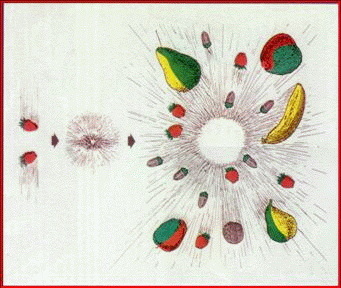Questions & Answers
 (Credit: CERN) |
Nega makes things clear |
-
The story says that Scientists, through
experiments, study elementary
particles and the forces that keep them together to form
matter. How do they do this? Can you give me an example of an experiment?
Imagine the long empty pipe (ring shaped) of a Machine designed to accelerate particles , called
an
Accelerator
, called
an
Accelerator . Inside this
pipe Scientists circulate
protons
. Inside this
pipe Scientists circulate
protons ,
for example, which can
reach extremely high speed, close to the speed of light, and therefore with very high
energy. Then the protons are driven to collide with a motionless target or
against antiprotons moving at high energy but in the opposite direction to
that of the incoming protons.
,
for example, which can
reach extremely high speed, close to the speed of light, and therefore with very high
energy. Then the protons are driven to collide with a motionless target or
against antiprotons moving at high energy but in the opposite direction to
that of the incoming protons.
Do you remember the formula E = mc2 mentioned in the story? From this formula it's evident that energy and mass are two exchangeable forms of the same realty. That's why, in the impact between protons and antiprotons at high energy, new matter is created in the form of many particles, sometimes new or predicted by some Theory. From a study of the particles produced, you can get information on the properties of the particles and on the forces they interact with.
The figure above, from a CERN
 publication,
shows clearly what happens in a
collision between two particles with a fanciful image of everyday objects.
Two strawberries, travelling at high speed and with great energy, collide:
their energy changes into matter and creates many fruits that didn't exist
before, some similar to the previous ones and some completely new.
publication,
shows clearly what happens in a
collision between two particles with a fanciful image of everyday objects.
Two strawberries, travelling at high speed and with great energy, collide:
their energy changes into matter and creates many fruits that didn't exist
before, some similar to the previous ones and some completely new.
-
What is the reason for making protons come into collision with moving
antiprotons instead of motionless protons? This seems strange.
This serves to have more energy in the collision. Think back again to the already mentioned formula E = mc2 which tells us that energy and mass can be converted one into the other. Well, keeping this in mind, Scientists learned many decades ago to use collisions at high energy between elementary particles to "create" matter.However, in the case of the collision of a moving proton with a motionless target, only a part of the energy of the bullet-particle is available to transform into matter. Let's see why.
A bullet proton, accelerated to a speed close to that of light, increases its mass considerably. In other words, the bullet proton, which can be considered as a bike at rest, becomes 500 times heavier; it becomes a truck. So, just as a moving truck can't be stopped by the impact against a bike, which is dragged away, the proton coming at high speed against a motionless brother drags it along with it. Its initial energy is mainly spent on making the target-bullet system move.
Now, let's suppose that two particles, both at high energy (two trucks), collide frontally. Let's also suppose, for example, that they stop in the position of the impact, losing all their moving energy. So, in this case, all their initial energy can be used to produce matter. The saving in terms of energy is enormous.
That's why a "colliding beams Machine" (collider
 )
has been designed in
which beams of protons and antiprotons at extremely high energy are driven to
collide frontally. In this way the energy available for the transformation
into matter is higher, much higher, compared to the energy available when a
proton beam strikes against a motionless target.
)
has been designed in
which beams of protons and antiprotons at extremely high energy are driven to
collide frontally. In this way the energy available for the transformation
into matter is higher, much higher, compared to the energy available when a
proton beam strikes against a motionless target.
-
Has
the idea of the frontal collision between protons and antiprotons at high
energy led to any interesting results?
Scientists have used this idea to "create" some particles (that had only been hypothesised before) in the laboratory, confirming a very important theory which tries to explain our World.In 1983, in the CERN Laboratories of Geneva, a group of Scientists (led by the Italian C. Rubbia, Nobel Prize for Physics in 1984) verified the so called "Electroweak Theory".
Based on this theory the electromagnetic
 and
weak interactions
and
weak interactions are two different aspects of the
same force called "electroweak"
interaction. In other words, the theory gives a "unified" description of the
two forces and supposes that these two forces are not "distinguishable" at
higher energies.
are two different aspects of the
same force called "electroweak"
interaction. In other words, the theory gives a "unified" description of the
two forces and supposes that these two forces are not "distinguishable" at
higher energies.The experimental confirmation of this hypothesis has been a fundamental step in the story of Physics. Note that they are two of the four "fundamental interactions" of Nature.
It's important to keep in mind that it's experimental verification which establishes, by means of a concrete fact, the truth of a theory, and also that a theory describes a real situation that can be observed in Nature.
One curious fact to note: Scientists gave these particles, that in some way tell us about our World, very strange names such as Z0 particle, W+ boson and W- boson
 .
.